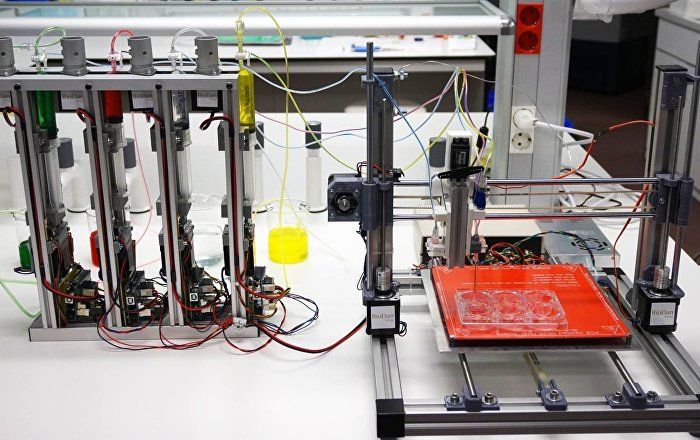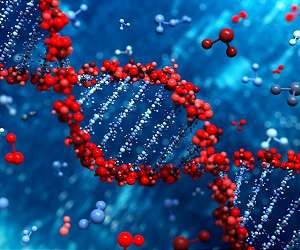The discovery that living and dead cockroaches have strikingly different magnetic properties could help bioengineers design new magnetic sensors.



A 3D bioprinter able to create human skin is already being used to help burns patients and carry out skin testing, Alfredo Brisac, CEO of Spanish bioengineering company BioDan, told Radio Sputnik.
Last month, scientists at Universidad Carlos III de Madrid and the BioDan Group presented a prototype 3D bioprinter that can create human skin suitable for transplantation to patients or for use in cosmetic, chemical or pharmaceutical testing.
One of the first living human organs to be created using bioprinting, the 3D-printed skin is created using bio-inks with living cells that are deposited onto a structure that replicates nature. The bio-ink contains the key elements of keratinocytes, fibroblasts and fibrin, which can recreate the structure of the skin.

Scientists from the Universidad Carlos III de Madrid (UC3M), CIEMAT (Center for Energy, Environmental and Technological Research), Hospital General Universitario Gregorio Marañón, in collaboration with the firm BioDan Group, have presented a prototype for a 3D bioprinter that can create totally functional human skin. This skin is adequate for transplanting to patients or for use in research or the testing of cosmetic, chemical, and pharmaceutical products.
This research has recently been published in the electronic version of the scientific journal Biofabrication. In this article, the team of researchers has demonstrated, for the first time, that, using the new 3D printing technology, it is possible to produce proper human skin. One of the authors, José Luis Jorcano, professor in UC3M’s department of Bioengineering and Aerospace Engineering and head of the Mixed Unit CIEMAT/UC3M in Biomedical Engineering, points out that this skin “can be transplanted to patients or used in business settings to test chemical products, cosmetics or pharmaceutical products in quantities and with timetables and prices that are compatible with these uses.”
This new human skin is one of the first living human organs created using bioprinting to be introduced to the marketplace. It replicates the natural structure of the skin, with a first external layer, the epidermis with its stratum corneum, which acts as protection against the external environment, together with another thicker, deeper layer, the dermis. This last layer consists of fibroblasts that produce collagen, the protein that gives elasticity and mechanical strength to the skin.

An interaction between two proteins enables cancer cells to use the physical forces of healthy cells to start spreading to other parts of the body.
The finding by researchers from the Francis Crick Institute in London and the Institute for Bioengineering of Catalonia (IBEC) in Barcelona is published in the journal Nature Cell Biology.
The process by which cancer cells separate from the original tumour to form new tumours in other organs or tissues of the body is called metastasis, and it is responsible for the majority of deaths in patients with cancer.

Electronic circuits are found in almost everything from smartphones to spacecraft and are useful in a variety of computational problems from simple addition to determining the trajectories of interplanetary satellites. At Caltech, a group of researchers led by Assistant Professor of Bioengineering Lulu Qian is working to create circuits using not the usual silicon transistors but strands of DNA.
The Qian group has made the technology of DNA circuits accessible to even novice researchers—including undergraduate students—using a software tool they developed called the Seesaw Compiler. Now, they have experimentally demonstrated that the tool can be used to quickly design DNA circuits that can then be built out of cheap “unpurified” DNA strands, following a systematic wet-lab procedure devised by Qian and colleagues.
A paper describing the work appears in the February 23 issue of Nature Communications.

Last week, the US Patent and Trademarks Office ruled on the most-watched patent proceeding of the 21st century: the fight for Crispr-Cas9. The decision was supposed to declare ownership of the rights to the revolutionary gene editing technique. But instead, the patent judge granted sorta-victories to each of the rival parties—a team from UC Berkeley and another with members from both MIT and Harvard University’s Broad Institute. That’s great for those groups (and their spin-off, for-profit gene editing companies with exclusive licenses). But it leaves things a bit murkier for anyone else who wants to turn a buck with gene editing.
The Crispr discoverers now have some authority over who gets to use Crispr, and for what. And while exclusive licenses aren’t rare in biotech, the scope of these do stand out: They cover all the 20,000-plus genes in the human genome. So this week, legal experts are sending a formal request to the Department of Health and Human Services. They want the federal government to step in and bring Crispr back to the people.
Crispr is new, but patent laws governing genetic engineering date back decades. In 1980, shortly after the Supreme Court ruled that genetically engineered microbes were patentable, Congress passed something called the Bayh-Doyle Act. The law gives permission for universities to patent—and license—anything their researchers invented with public funds, making it easier to put those inventions back in the hands of citizens.

DNA, the stuff of life, may very well also pack quite the jolt for engineers trying to advance the development of tiny, low-cost electronic devices.
Much like flipping your light switch at home — –only on a scale 1,000 times smaller than a human hair — –an ASU-led team has now developed the first controllable DNA switch to regulate the flow of electricity within a single, atomic-sized molecule. The new study, led by ASU Biodesign Institute researcher Nongjian Tao, was published in the advanced online journal Nature Communications ( DOI: 10.1038/ncomms14471).
“It has been established that charge transport is possible in DNA, but for a useful device, one wants to be able to turn the charge transport on and off. We achieved this goal by chemically modifying DNA,” said Tao, who directs the Biodesign Center for Bioelectronics and Biosensors and is a professor in the Fulton Schools of Engineering.

Donate to the Methuselah Foundation here at this link
Methuselah Foundation reviewed the progress they made over the past year. Much of what you’ll read in this year in review letter is very late-breaking, and leads us to believe that 2017 will be a very important year in medical developments. 2016 took us a broad step closer to fulfilling our mission statement to “Make 90 the New 50, by 2030”. Why can we say that? For starters, let’s look at several achievements to date that made this year so successful:

Orginal press: http://www.prweb.com/releases/2017/02/prweb14062199.htm
Bioquark, Inc., (http://www.bioquark.com) a life sciences company focused on the development of novel biologics for complex regeneration and disease reversion, and SC21 Biotech, (http://www.sc21bio.tech), a biotechnology company focused on translational therapeutic applications of autologous stem cell therapy, have announced a collaboration to focus on novel cellular reprogramming and production approaches for CCR5 Delta32 homozygous cord blood stem cells, for long-term control of HIV via transplantation.
“We are very excited about this collaboration with SC21 Biotech,” said Ira S. Pastor, CEO, Bioquark Inc. “The natural synergy of our cellular reprogramming tools and SC21 Biotech’s translational cell therapy experience, will make for a transformational opportunity in this area of HIV disease control.”
HIV-1 infection afflicts more than 35 million people worldwide. For individuals who have access to antiretroviral therapy, these drugs can effectively suppress, but not cure, HIV-1 infection. The only documented case for an HIV/AIDS cure was a patient with HIV-1 and acute myeloid leukemia who received allogeneic hematopoietic cell transplantation from a graft that carried the HIV-resistant CCR5-Delta32 homozygous mutation. The patient has remained without any evidence of HIV infection for more than 8 years after discontinuation of antiretroviral drug therapy.
However, identifying immune matched adult CCR5- Delta32 homozygous donors for a given patients is not readily feasible in part because the prevalence is in only about 0.8%–1% of individuals of northern European descent and much less in other ethnic groups, as well as the fact that for such transplants with adult cells there needs to be a very close HLA match between donor and patient.

In contrast, cord blood that is CCR5- Delta32 homozygous provides a major advantage in that much less stringent HLA matching is required between donor and patient. However, a technological method to cost effectively and industrially scale the production of such cells has been missing.
“We look forward to working closely with Bioquark Inc. on this exciting initiative,” said Mr. Paul Collier, Managing Director of SC21 Biotech. “The ability to apply Bioquark’s cellular reprogramming tools in order to produce industrial quantities of such precious cell lines will offer a much greater global penetration of this important therapeutic modality for HIV.”
“Bioquark has spent several years studying the evolutionarily perfected ability of bioactive moieties found in ooplasms to turn back biological time and re-set cellular regulatory state” said Dr. Sergei Paylian, Founder, CSO, and President, Bioquark Inc. “This unique initiative is one more step in our broad translation of such natural capabilities to control the progression of human diseases.”

About Bioquark, Inc.
Bioquark Inc. is focused on the development of natural biologic based products, services, and technologies, with the goal of curing a wide range of diseases, as well as effecting complex regeneration. Bioquark is developing both biological pharmaceutical candidates, as well as products for the global consumer health and wellness market segments.
About SC21 Biotech
SC21 Biotech is a novel a biotechnology company focused on translational therapeutic applications, as well as expedited, experimental access for “no option” patients, to a novel range of regenerative and reparative biomedical products and services, with the goal of reducing human degeneration, suffering, and death.